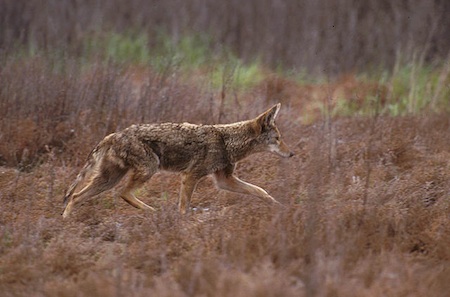By Ellen Girardeau Kempler
 In neighborhoods bordering Laguna’s wilderness, there’s a natural echo you often hear when fire engines answer a nighttime call. The primal, high-pitched yips, yaps, yelps and howls of coyote packs riled by such urban sounds as sirens, alarms and domestic dogs send shudders down the spines of pet owners all over Southern California. Our local folklore is full of true stories about coyotes snatching cats from backyards in broad daylight, following dog walkers, and silently observing dogs at play. Lost cat signs are an everyday part of our urban landscape.
In neighborhoods bordering Laguna’s wilderness, there’s a natural echo you often hear when fire engines answer a nighttime call. The primal, high-pitched yips, yaps, yelps and howls of coyote packs riled by such urban sounds as sirens, alarms and domestic dogs send shudders down the spines of pet owners all over Southern California. Our local folklore is full of true stories about coyotes snatching cats from backyards in broad daylight, following dog walkers, and silently observing dogs at play. Lost cat signs are an everyday part of our urban landscape.
As a new resident, I was told to keep my outdoor cat indoors. After he managed to escape and (predictably) disappeared, a friend told me she’d heard there were caves near Top of the World full of pet collars and tags. It’s a legend I’ve never been able to confirm, but an image that’s difficult to forget. On the top of the heap: A frayed baby blue collar and a round metal tag engraved with my cat’s name.
Fossil skeletons of coyotes suggest that they evolved alongside (now extinct) dire wolves starting 1.8 million years ago, during the Pleistocene Epoch. Coyotes were appropriately named for coyotl, Aztec for trickster, crafty star of countless Native American legends. Lewis and Clark called them prairie wolves.
Unlike wolves, whose numbers have declined with human population growth, coyotes’ range has expanded far beyond prairies. Coyotes have established their territory in even the most developed places. Biologists recently documented 200 coyotes living successfully in Chicago’s industrial parks and skyscraper canyons, thriving on a diet made up mainly of rodents, Canada geese and their eggs.
In Chicago as in Laguna, coyotes try to avoid human contact. You can help keep coyotes wild by feeding pets indoors and bringing them inside at night, closing trashcan lids and properly disposing of litter. In the rare event that you do see a coyote, don’t run. Give it space and consider yourself lucky to have seen it. Left to follow their natural hunting patterns, coyotes will maintain their natural fear of humans, help control wild rodent populations and leave dogs and cats alone.
The former communications director of Laguna Art Museum and Laguna Canyon Foundation, Ellen Girardeau Kempler is founder and chief navigator of Laguna-based Gold Boat Journeys. She specializes in travel planning, writing, strategic marketing and social media training. Contact her at [email protected].





Nice article, with lots of good and accurate information. However, when you see a coyote, don’t “give it space”, move toward it in a dominent manner,claiming the habitat as human space. It is the coyote who must give you space. Do as experts describe the recommended “hazing” procedure. This let’s it knoow we are not indifferent to its presence and so they will not get comfrotable with your presence. The attitude is not to revel in the experience of seeing a beautiful wild animal, but to dominate them. This may seem cruel, but this will keep both coyotes and people safe.
Thanks for your correction, Chris. I agree I should have clarified my advice–which only applies to coyotes not acting aggressively, like the ones I often see from a distance when walking Top of the World’s fire road. Of course, an aggressive coyote should be scared off with a big performance of human dominance: noise and standing up to claim the space. If we avoid careless practices like leaving pet food outside, we’ll avoid these kinds of clashes between humans and the beautiful animals just trying to survive in our wilderness.
Ok, if a coyote is far away and doesn’t notice you, that’s fine. But please check, I think they recommend we haze not only for aggressive coyotes but also for relaxed, calm, casual ones that seem “habituated” to human presence; that treat it as no big deal.
Thanks, Chris. I found this helpful PDF from the Humane Society on what people can do to scare (called hazing) coyotes that come too close or do not display fear around humans. http://www.humanesociety.org/assets/pdfs/wild_neighbors/coyote_hazing.pdf